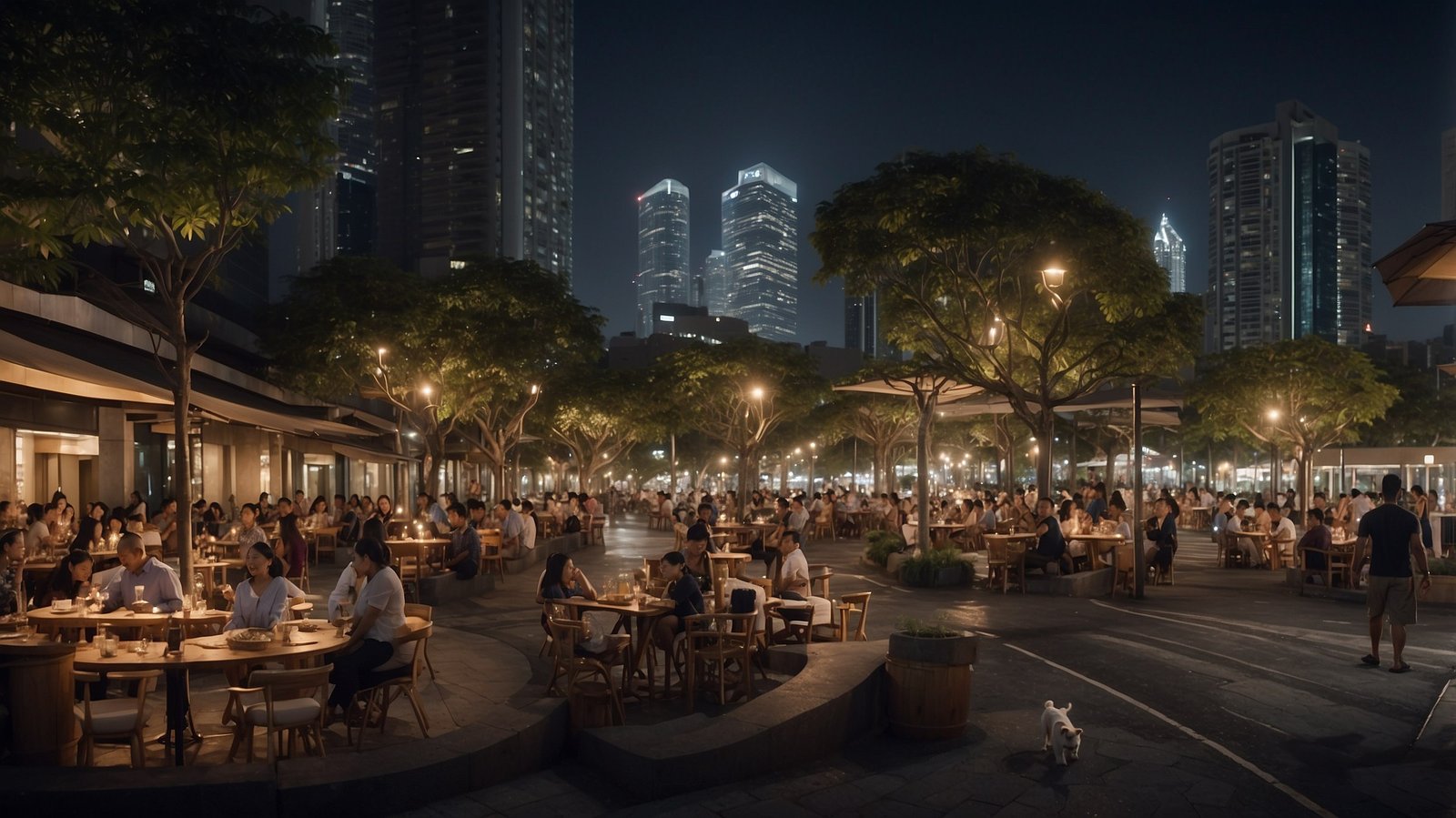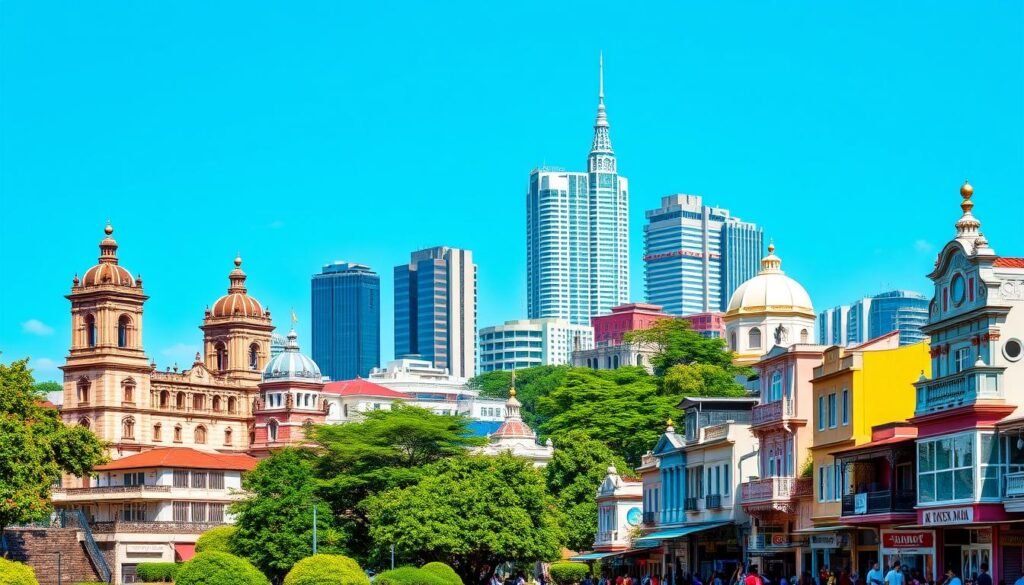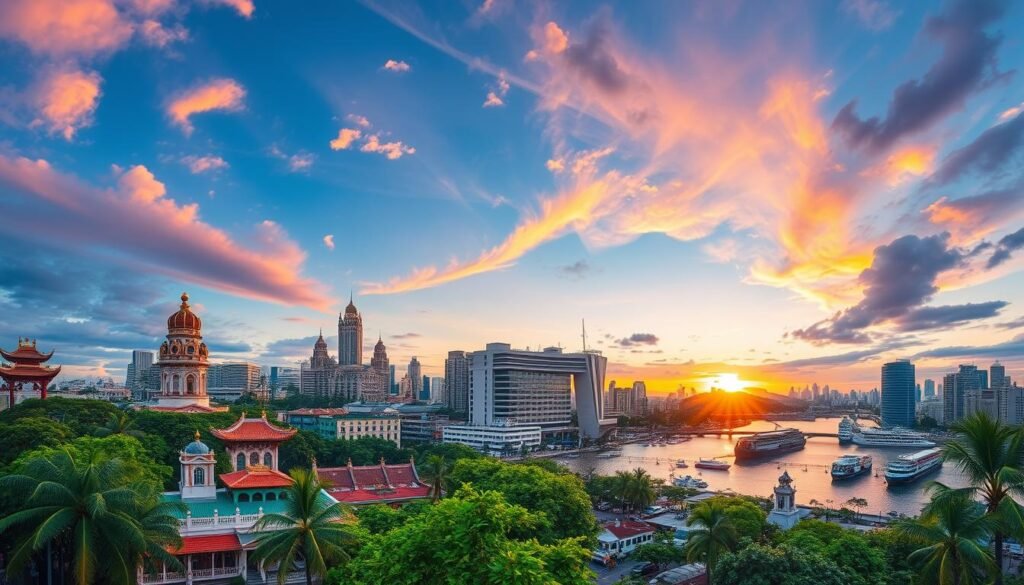Manila is the most densely populated city in the world. It’s a vibrant and bustling metropolis. Travelers can explore the historic heart of Intramuros or try the delicious Filipino cuisine.
There’s no shortage of amazing things to do in this dynamic city. Whether you’re looking for cultural immersion, lively nightlife, or modern urban adventures. This guide will help you uncover the best of Manila and make the most of your visit.
Introduction to Manila: The Gateway to the Philippines
Manila is the capital and largest city of the Philippines. It’s a lively city that welcomes many travelers. The city and its surrounding areas, like Makati, Pasay, and Quezon City, make up Manila’s metropolitan area. Here, you can experience a mix of old and new, making it a unique place to visit.
Understanding Manila’s Metropolitan Areas
Manila’s area is very crowded, with over 23 million people living there. It’s split into different cities, each with its own vibe. You can find financial centers, lively areas, and big cities all in Manila.
Brief History and Cultural Significance
Manila started in the 16th century as a Spanish colony. Over time, it has been influenced by many cultures. Today, you can see this history in places like Fort Santiago, San Agustin Church, and the Manila Cathedral.
What Makes Manila Unique
Manila is special because it mixes old and new perfectly. You can see ancient buildings and museums next to modern shopping and architecture. This mix makes Manila a place where you can learn about history and enjoy today’s culture.

Best Time to Visit Manila
Planning a trip to Manila? The dry season, from December to February, is the best time. Temperatures are just right, ranging from 75°F to 88°F. This makes it perfect for exploring the top Manila destinations and best places in Manila.
The dry season is a welcome break from the humidity and typhoons of the wet season. The wet season is from May to October. While it’s still fun to visit then, the dry months are better for sightseeing and outdoor fun.
- February is a great time to visit the Philippines. The rainy season has ended, and it’s a bit cooler.
- January is also a top choice. The Feast of the Black Nazarene, a big religious event, happens on the 9th.
- The Ati-Atihan festival in Kalibo, Aklan province, and the Dinagyang festival in Iloilo, both in January, attract many visitors.
Manila is great to visit any time, with its rich culture, history, and modern sights. Visiting during the dry season lets you enjoy the city fully. You’ll dive into its lively atmosphere.

Getting to and Around Manila
Manila is the capital and largest city of the Philippines. It has a wide range of transportation options. Knowing how to get around is essential for a smooth trip.
Airport Transportation Options
NAIA is Manila’s main airport, welcoming millions of visitors yearly. You can use UBE Express buses, Grab, or private transfers to reach your destination. UBE Express offers direct shuttles, while Grab is a reliable choice for getting around.
Public Transportation Guide
Manila’s public transport includes MRT, LRT, jeepneys, and tricycles. The BEEP card is great for frequent users. These options are affordable and efficient for exploring the city.
Ride-Hailing Services and Taxis
Grab is a top choice for convenient travel in Manila. It offers a smooth experience with Grab booths at airports. Taxis are also available, but watch out for overcharging and have the right change.
Knowing your transportation options in Manila helps plan your trip well. This way, you can enjoy your time in this vibrant city.
Where to Stay in Manila
Manila has many places to stay, each with its own charm. Poblacion in Makati is a favorite for its central spot and wide range of places to stay. You can find hostels like Z Hostel, boutique hotels like La Casita Mercedes, and business hotels like City Garden Grand Hotel.
Makati and Bonifacio Global City (BGC) are modern and close to Manila’s business centers. They’re great for both fun and work trips. Near Intramuros, you can easily visit Manila’s cultural and historical spots.
- Poblacion, Makati – A lively area with hostels, boutique hotels, and cool restaurants.
- Makati – Manila’s financial hub with hotels and serviced apartments for all budgets.
- Bonifacio Global City (BGC) – A modern area with luxury hotels, malls, and offices.
- Intramuros – Manila’s historic center with places to stay that let you dive into the city’s past.
Looking for manila accommodations with luxury or a simple place to stay? Manila has it all. With its many neighborhoods and lodging choices, your visit is bound to be memorable.
What to Do in Manila: Top Attractions and Activities
Manila, the vibrant capital of the Philippines, has a lot to offer. You can explore its rich history or dive into its lively culture. There’s something for everyone in this dynamic city.
Historical Sites and Museums
Start by visiting Intramuros, the historic walled city from the Spanish era. Walk its cobblestone streets and see the iconic Fort Santiago. Don’t miss the stunning Manila Cathedral.
At the National Museum Complex, you can see the Philippines’ art and culture. It has museums for fine arts, anthropology, and natural history.
Shopping Districts and Markets
For a modern feel, check out Manila’s shopping spots. Bonifacio Global City (BGC) has chic boutiques and trendy places to eat. Divisoria’s 168 Shopping Mall is great for finding deals on many products.
Cultural Experiences
Experience Manila’s diverse culture by visiting Binondo, the world’s oldest Chinatown. Try Chinese food, see Binondo Church, and feel the area’s energy. Casa Manila museum offers insights into Spanish colonial Manila. Enjoy traditional Filipino shows that highlight the country’s culture.
Manila has more to offer than just famous spots. See the sunset at Manila Bay Baywalk. Try unique food at Blackbird in a former airport tower. Explore the city’s street art in different neighborhoods.
Exploring Intramuros: Manila’s Historic Heart
Intramuros, Manila’s walled city, takes you back in time. It’s the historic heart of the Philippines’ capital. Exploring Intramuros is a must for anyone wanting to learn about the country’s rich culture.
Take a guided bamboo bicycle tour to see Intramuros. These eco-friendly bikes let you slowly explore the narrow streets. You’ll see stunning Spanish colonial architecture and landmarks like Fort Santiago and San Agustin Church.
Don’t miss Papa Kape, a café in a 400-year-old water cistern. Here, you can try unique local coffee blends. It’s a great place to learn about Intramuros’ history.
Exploring Intramuros helps you understand Manila’s complex past. You’ll see how the city changed from Spanish rule to American occupation and independence. A visit to Rizal Park is a moving reminder of the Philippines’ fight for freedom.
If you love history or just want to see the Philippines’ culture, Intramuros and its historic sites are unforgettable. Start a journey through this neighborhood and discover the heart of Manila.
Modern Manila Adventures
Manila, the vibrant capital of the Philippines, is a mix of modern fun and cultural richness. You’ll find sleek skyscrapers in Bonifacio Global City and the urban charm of Makati. There’s always something exciting to do in this lively city.
Bonifacio Global City Highlights
Bonifacio Global City, or BGC, is a true modern Manila gem. It’s known for its modern architecture, trendy eateries, and cool street art. Walk around and see the tall buildings and colorful murals. Try out the diverse food scene with dishes from all over the world.
Makati’s Urban Attractions
Makati is close to BGC and is full of manila urban attractions. It’s a place for luxury shopping at Ayala Malls. You can also visit the Ayala Museum to learn about Filipino art and culture.
Entertainment Districts
- Poblacion in Makati is great for nightlife. It has many bars, speakeasies, and restaurants. It’s perfect for those who love to explore different cultures.
- SM Mall of Asia is a big place for shopping, eating, and fun. You can see Manila Bay while you’re there. It has lots of shops, movies, and activities.
Looking for modern vibes in BGC or urban charm in Makati? Modern Manila has lots of adventures. It’s a place that will excite your senses and show you the city’s lively spirit.
Culinary Journey Through Manila
Start a thrilling manila food tour and dive into the rich tastes of filipino cuisine. Manila’s food scene is a mix of traditional Filipino dishes and international flavors. Explore the lively streets of Binondo and the trendy spots in Makati for a feast of flavors.
In Binondo, the oldest Chinatown, enjoy a true Chinese-Filipino fusion. Try the crispy lumpia and the hot sisig, a dish with grilled pork, chicken liver, and calamansi. Also, visit the Destileria Limtuaco Museum for a taste of traditional Filipino spirits and liqueurs.
For a modern twist on Filipino food, check out Manam in Makati or Toyo Eatery, listed on Asia’s 50 Best Restaurants. These chefs bring new life to classic dishes, showing the richness of filipino cuisine.
Indulge in local sweets like halo-halo and puto bumbong. The Manila Hotel’s Cafe Ilang-Ilang has a huge filipino cuisine buffet. It’s a chance to try many dishes at once.
Manila offers everything from street food to fine dining. A manila food tour will excite your taste buds and create lasting memories. Let your taste guide you through this vibrant food scene.
Manila’s Nightlife and Entertainment
Manila, the lively capital of the Philippines, has a great nightlife. It has everything from fun clubs to cozy rooftop bars. The city is full of entertainment options once the sun goes down.
Popular Nightlife Districts
Poblacion in Makati is the center of Manila’s nightlife. It has a bustling night market with international street food, craft beers, and a fun vibe. The area has many bars, clubs, and restaurants, each offering something special.
Cultural Shows and Performances
Manila is also known for its cultural shows. Places like the Cultural Center of the Philippines and Resorts World Manila showcase traditional dance, music, and theater. It’s a great way to experience Filipino culture.
Rooftop Bars and Lounges
Manila’s nightlife gets even better with its rooftop bars and lounges. Places like The Nest at Vivere in Alabang and City Garden Grand Hotel’s Firefly Roofdeck Bar in Makati offer amazing views. They also serve great cocktails in a lively setting.
Manila’s nightlife and entertainment options are for everyone. Whether you’re into clubs, cultural shows, or rooftop bars, there’s something for you. It’s a great way to enjoy the city’s vibrant after-dark scene.
Day Trips from Manila
Manila, the capital and largest city in the Philippines, is close to many exciting places. You can find peaceful nature spots, historical sites, or cultural experiences. These trips offer a break from the city’s hustle and bustle.
Nature lovers should visit the Seven Lakes of San Pablo in Laguna. Here, you can enjoy rafting and hiking. Nearby, the Masungi Georeserve in Rizal is known for its unique landscapes and wildlife.
- Explore the ancient Angono Petroglyphs and artist community in Rizal
- Hike the trails of Mount Daraitan and cool off in the nearby Tinipak River
- Discover the historical significance of Corregidor Island, a former military stronghold
For a natural adventure, head to Mount Pinatubo crater. It’s a challenging hike with amazing views. Or, see the Taal Volcano from Tagaytay, a two-hour drive from Manila.
These are just a few of the many day trips you can take from Manila. The city’s location and attractions make it a great starting point for exploring the Philippines.
Conclusion
Reflecting on my time in Manila, I see a city that’s both old and new. I’ve seen ancient sites like the Quiapo Church and Manila Cathedral. I’ve also enjoyed the modern food and nightlife.
Dealing with Manila’s busy streets and traffic can be tough. But with good planning and an open mind, you can enjoy all it offers. Whether you’re looking for street food or fancy dining, Manila has something for everyone.
Before I leave, I’ve gained a new respect for Manila’s culture. The city is a mix of Christian, Muslim, and other faiths. With over 14 million people, Manila shows the strength and diversity of its people. They’ve faced many challenges and continue to shape the city.

